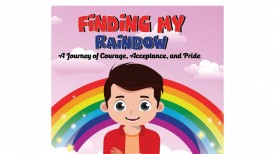New Book ‘Eyes that Weave the World’s Wonders’ Encourages Transracial Adoptees to Embrace Their Identity
New York Times bestselling author Joanna Ho collaborated with award-winning educator Liz Kleinrock in writing a companion picture book on adoption and family. Titled "Eyes that Weave the World's Wonders," the story centers on a young transracial adoptee who learns to embrace her Asian eyes and discovers profound familial connection and significance in them despite their visual dissimilarity to her parents.
Through a deep bond filled with love, she contemplates her birth mother. She develops a newfound appreciation for both her birth culture and her adopted family's culture. Ultimately, she learns to value the diversity within her family and finds beauty in their differences, celebrating the unique blend that makes her who she is.
Champions for Equity and Education
Kleinrock is a transracial adoptee and educator advocating against racism. As a transracial adoptee originally from South Korea, Kleinrock was raised in Washington, DC. She is dedicated to promoting equity through her work with Teach and Transform.
Ho is a celebrated author known for bestsellers. Beyond writing, Ho has held roles as an English teacher, dean, vice principal, and professional development expert. Her commitment to fairness in books and education is matched by her fondness for homemade chocolate chip cookies, outdoor escapades, and dance parties with her children.
Ho's previous works include "Eyes that Kiss in the Corners" and "Eyes that Speak to the Star," both of which explore eyes as symbols of identity and belonging. For Ho, eyes are prominent features on our faces, making any differences immediately noticeable. In her stories, eyes serve as a way for characters to explore their sense of belonging. Additionally, eyes carry familial stories, histories, and love, both physically and symbolically, passed down through generations.
Exploring Identity and Belonging
Deepa Fernandes, host of WBUR's "Here & Now," interviewed both authors of the book. Fernades praised the book's beauty and poignant writing, noting illustrations of a happy family in ordinary settings. The story delves into deeper questions when one child, though smiling in the family photos, appears different from the rest.
Kleinrock explained that starting from this point allows many children and family members to relate, as most have seen similar family pictures. For transracial adoptees and biracial or multiracial children, these images might evoke complex emotions about belonging and fitting in.
READ ALSO: 6 Books to Read for April's Total Solar Eclipse
Fernades read an excerpt from the book that emphasizes the complex emotions adoptees may experience, blending love and pain. When asked about how her experience as a transracial adoptee influenced the book's themes and narrative style, Kleinrock explained that adoption can evoke both painful and positive emotions, including trauma, separation, loss, and grief, alongside love and gratitude. She shared that, like many adoptees, she navigated a duality of emotions, experiencing both sadness and appreciation for her parents.
The book depicts the main character with darker skin than her family. Mirroring her own experience, Kleinrock shared that being the only person of color in her family, including extended relatives, and growing up in a predominantly white neighborhood made her acutely aware of her racial identity from a young age. She emphasized the importance of books like this one in starting conversations and affirming diverse perspectives, especially for adoptees whose stories have often been told by non-adopted individuals.
Feedback and Challenges
Kleinrock expressed that it felt surreal and shared that the feedback has been overwhelmingly positive, with adoptees and parents expressing gratitude for the book. However, she mentioned facing challenges, particularly from a small but vocal group of adoptee activists who made assumptions about the book based on marketing images without reading it.
According to Ho, criticisms noted the lack of representation in publishing and the problematic portrayals of adoptee experiences in some existing literature. Kleinrock added that critique from within the adoption community hit differently but noted that negative comments largely disappeared after the book's release, indicating the nuance conveyed in the story.
Kirkus review praised the book for addressing complex feelings and questions surrounding adoption, such as 'who,' 'what if,' and 'why.' The reviewer commended Ho's illustrations for their rich detail and warm colors, which complemented the narrative seamlessly. The reviewer also highlighted how the child in the story navigates dreams and stories, ultimately finding beauty in connections to a birth parent.
Overall, the book is a striking adoption tale that encourages the exploration of larger questions and emotions.
RELATED ARTICLE: Malia Maunakea Set to Release Her Second Children's Book 'Lei and the Invisible Island'
© 2023 Books & Review All rights reserved.
Popular Now
1
Books to Read After 'Fourth Wing': Top Picks for Fantasy and Romantasy Fans

2
‘The Secret Public’ by Jon Savage Book Review: An Insightful Look Into the LGBTQ Influence

3
Stephanie Regalado's 'If They Only Knew' Column Is Now A Book, Unleashing 60 Anonymous True Stories to Empower Women

4
'No Wire Hangers' Scene That Almost Did Not Happen: New Book Reveals Faye Dunaway's Struggles

5
Rare First Edition of Aphra Behn's Novel 'Oroonoko' Discovered in Kent: A Historic Literary Find

Latest Stories
Book Reviews
‘The Secret Public’ by Jon Savage Book Review: An Insightful Look Into the LGBTQ Influence

Book News
Stephanie Regalado's 'If They Only Knew' Column Is Now A Book, Unleashing 60 Anonymous True Stories to Empower Women

Book News
'No Wire Hangers' Scene That Almost Did Not Happen: New Book Reveals Faye Dunaway's Struggles

Book Reviews
‘The Perfect Couple’ by Elin Hilderbrand Book Review: A Captivating Summer Mystery

Book News
New Book ‘The Franchise’ Reveals Penguins President Kyle Dubas’ ‘Biggest Mistake’ as Maple Leafs GM











